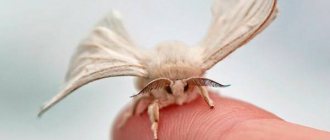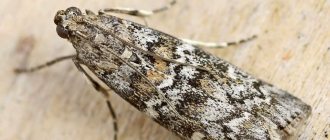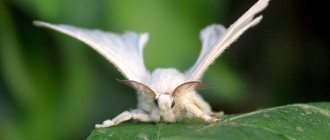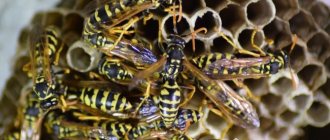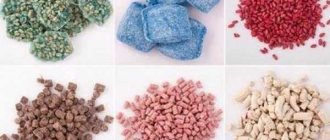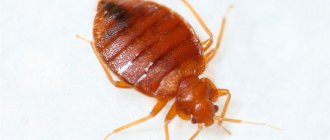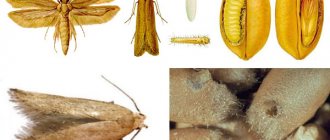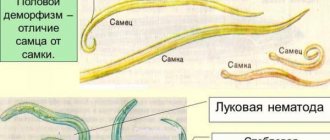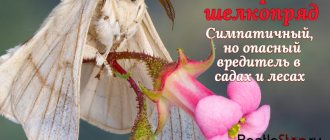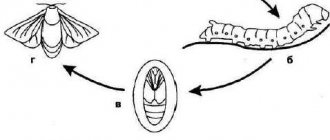Many butterflies are pests. One of these is the pine silkworm, or, as it is also called, the cocoon moth. The insect harms conifers. Belongs to the group of pine-eaters. More often, the cocoon moth infects pine trees. The insect at the caterpillar stage is quite voracious. When an individual appears, it is necessary to urgently begin to fight it. Otherwise, coniferous plants will be completely destroyed and will not be able to grow further.
Cocoon moths are considered pests
Pine silkworm (Dendrolimus pini)
Pest type : Pests of coniferous species Series : Lepidoptera - Lepidoptera
Family : cocoon moths - Lasiocampidae
Found everywhere. Damages Scots pine and, in rare cases, other conifers.
A butterfly with a wingspan of 60-80 mm, the color of the front wings is from yellow-brown to gray-brown, on each wing there are three transverse wavy lines and up to the middle of the wing there is a small semi-lunar white spot; when at rest, the wings are folded like a roof; the hind wings are gray, one-color. The egg is up to 2 mm in diameter, greenish at first, later dark. The last instar caterpillar is 90-100 mm long, gray-brown, with sparse reddish hairs, with dark blue spots on the dorsal side of the second and third segments; A row of rhombic spots with a light center stretches along the back. The pupa is 20-40 mm long, dark brown, in a cocoon.
Caterpillars of the third and fourth centuries overwinter in the forest floor, most often near a tree trunk; some individuals move shallowly into the soil. In the spring, at a temperature of 10 °C at the location where the caterpillars are located, they crawl along the trunks into the crown and begin to feed on young needles; they also damage May shoots and buds. They feed in the twilight and predawn hours. Over the entire development period, one caterpillar eats 20-35g of needles, 2-3g in the fall and 18-32g in the spring. Male caterpillars travel 6 centuries, female caterpillars - 7 centuries. They pupate in the first half of June among the needles on branches or on tree trunks. After 20-25 days the butterflies emerge. Their years last until mid-July.
After fertilization, females lay eggs on needles in groups of 20-150 pieces. Fertility - on average 300 eggs. After 14-20 days, the caterpillars are reborn, feeding on this year’s needles, gnawing the needles on the sides in the apical part. Caterpillars of the second instar gnaw the entire length of the needles. In October, the caterpillars move to wintering. The generation is annual.
Eating needles causes trees to weaken, branches to dry out and become infested with bark beetles and longhorned beetles.
The number of pine silkworms is reduced by more than 60 species of parasites and predators. The laid eggs are infested by egg eaters, caterpillars and pupae - braconids; ichneumonids, etc. Ants from the genus Formica and birds - cuckoo, oriole, jay - feed on caterpillars and pupae.
In wet weather, epizootics occur due to infection with fungal, bacterial and viral diseases.
Protective measures. Attracting and protecting insectivorous birds to plantings. If the number exceeds 400-500 caterpillars per tree, treat the forest litter and butt part of the trees with biological preparations or insecticides in the early spring.
Preventive actions
Any disease of common pine caused by fungal spores or pests is much easier to prevent than to treat. To maintain the health of pine seedlings and mature trees, the following rules must be observed:
- pay attention to the quality and level of soil moisture, regularly apply mineral fertilizers;
- plant pine in well-lit areas with good ventilation - many ailments develop precisely in conditions of shading and stagnant moisture in the soil;
- choose only high-quality seedlings and seed material for planting;
- annually carry out preventive treatment of pine trees with Bordeaux mixture and fungicidal substances; the products do not harm the plant, but help prevent the appearance of pests and carry out treatment in the early stages;
- regularly weed and loosen the soil at the roots of the pine tree and prevent the growth of weeds, many of them are intermediate carriers of fungal spores and pest larvae.
Advice! Every year it is necessary to carry out preventive pruning of pine trees and remove dry, damaged and diseased branches. After pruning and harvesting, needles, bark and shoots must be burned, otherwise bacteria and larvae from them will again spread to a healthy tree.
Dendrolimus pini
Pine moth, European pine moth, Pine moth,
Lepidoptera (Butterflies) - Lepidoptera
The pine cocoon moth is a pest of coniferous species and belongs to the group of pine-eating species of the summer-spring phenological complex. Caterpillars prefer Scots pine needles, less often than other types of conifers. Reproduction is bisexual. Development is complete. The generation is annual. Outbreaks of mass reproduction are most often observed in pine forests of the European part of Russia. Caterpillars overwinter on the forest floor. [6]
Click on photo to enlarge
What is the geography of distribution of the cocoon moth?
You can meet the pine silkworm wherever coniferous trees grow. On the territory of the Russian Federation, cocoon moths can be seen in large numbers along the banks of the Northern Donets.
The last mass reproduction was noticed on the territory of Russia in the 50-70s of the last century. Often pine trees are completely destroyed by silkworms. Unlike the cutworm, the cocoon moth prefers middle-aged plants.
Read on topic:
How to get rid of fruit flies
14.11.2020
Causes and methods of eliminating anthractosis
14.11.2020
Why do signs of blossom end rot appear on tomatoes?
14.11.2020
Signs of verticillium and ways to eliminate the fungus
14.11.2020
The insect prefers dry forests. This is due to the fact that silkworms die from fungal diseases where there is an increased level of humidity.
Morphology
Imago . Butterfly, wingspan 60 – 80 mm. The color varies, but is most often gray-brown. On the front wings there is a wide sinuous band from gray-brown to red-brown. In addition, on each of the front wings there is a small white crescent-shaped spot.
The hind wings are monochrome. The coloring and pattern of the wings help butterflies to perfectly mimic the color of pine bark. [1]
The antennae, like all members of the family, are double-combed. [4]
Sexual dimorphism
Individuals of different sexes differ in the structure of their genitalia.
Secondary sexual characteristics:
Female . The antennal ridges are shorter than those of males. [4]
The egg is large, from 1.8 to 2.5 mm. The shape is elongated spherical. At the beginning of development they are bluish-green, later gray with a faint shine and a dark dot at the top. [6]
The larva (caterpillar) immediately after hatching is yellowish-white with transverse rows of small black warts and an orange stripe on the sides of the middle part of the abdomen.
Adult caterpillars reach a length of up to 100 mm. The color is gray with sparse reddish hairs. On the II and III segments of the chest there are dark blue, almost black spots. Along the back there is a row of diamond-shaped spots with the middle being a lighter shade. [1]
The pupa is large, 18–40 mm long. The apex of the abdomen is rounded, has a convex plate, densely covered with reddish bristles. The pupa is located in a parchment-like cocoon, 30 to 50 mm long. The color of the cocoon covers is brownish or dirty gray. Tufts of burning dark hairs are woven into it. [6]
Phenology of development (in days)
Insects attacking needles, shoots and roots
A large number of insects belong to this group. They feed on bark, roots, needles, young and last year's shoots. If these pests appear in large numbers, they can even cause the death of the plant. Many of this group of pests are beetles.
The most common among them:
- gray pine weevil - adult beetles (up to 11 mm in length) feed on bark and needles, the larvae damage the roots;
- spot tar - small beetles (up to 7 mm) are dangerous for bark and needles, and the larvae gnaw passages in the tree;
- large pine weevil - prefers young trees.
Some pine pests are butterflies of the Shootweed family. This group includes summer shoot, resin shoot, bud shoot and wintering shoot. The larvae of these insects, which may differ, are dangerous for trees: in a wintering victorious grass it is a black caterpillar, in others it can be brown, gray, or orange.
When choosing what to spray pine against caterpillars, you should pay attention to the composition of the drug and instructions for use. For preventive treatments, it is better to use complex products that contain active ingredients against many insects simultaneously.
Pine pests are insects that, in the course of their life activity, damage the bark, shoots, needles or roots of trees. They can belong to different groups, but most often the larval stages cause harm. The fight against caterpillars should be annual. It is enough to use insecticides according to the instructions, and pests will not appear on the site.
Development
Imago . Butterfly flights are observed from mid-June to mid-July. [1]
Mating period . Reproduction is bisexual. Females lay fertilized eggs in groups of 20–150 pieces on needles, shoots and bark of stems. Fertility 280 – 330 pieces. [1]
Egg . At temperatures from +16°C to +18°C, the embryo develops in 16–20 days. [1]
The larva (caterpillar) , after hatching, gnaws the needles of the current year of growth, damaging the needles on the sides and in the apical part. From the second instar, the needles are gnawed along their entire length. After molting one more time around October, the caterpillars go to winter. Caterpillars of III–IV instars overwinter at a shallow depth in the forest floor, not far from the tree trunk from which they descend in the fall. In light soil they can go to a depth of 10 cm.
In spring, when the temperature of the surface layer of soil (depth up to 2 cm) rises to + 10 °C, the caterpillars awaken and climb up the trunks into the crown of fodder trees. There they begin to feed. The caterpillars of this species of cocoon moths are voracious and intensively destroy old needles. With a lack of nutrition, young needles are destroyed, buds and May shoots are gnawed off.
The caterpillars feed until mid-June. During this time they molt three to four times.
In total, during development, the number of molts reaches six, and ages - seven. [1]
The caterpillars prefer to feed on Scots pine needles. On other conifers they are found only when there is a lack of food. The species is light-loving, heat-loving, xerophilic. [2]
Doll . The caterpillar pupates on the branches and trunks of pine trees. Its development lasts 4–5 weeks. [6]
The adult emerges from the cocoon in mid-July. [1]
Features of development . The development cycle of the pine cocoon moth is one-year, but under unfavorable development conditions, the caterpillars can go to a secondary wintering and pupate only in the third summer. [1]
The outbreak of mass reproduction lasts 7–8 years. Foci of reproduction of the pine cocoon moth occur:
- in clean, dry pine forests with a fullness of average values, which are located at higher elevations;
- in green moss forests;
- in pine crops 12 – 40 years of age of varying completeness;
- on dry, poor soils, old arable lands and sands, isolated from natural pine forests. [2]
Give for nuts
Almost 450 million rubles are needed to save the cedar forests. It is planned to allocate about 50 million from the regional budget for next year to combat the Siberian silkworm. Therefore, the regional authorities turned to the Federation for support: Governor Sergei Zhvachkin wrote a letter to Rosleskhoz.
– We cannot write off the social significance of cedar forests. Most of them are village-based, that is, they are located near populated areas. And for many local residents, harvesting pine nuts is the main source of income,” emphasized Anton Balaburkin.
The ideal option is to treat the entire affected area. The optimal time for carrying out such work is the first ten days of May. At this time, the caterpillars emerge from the litter, climb into the crown and begin to actively feed. And at this moment it is necessary to strike from the air - to spray special means using air transport.
Siberian silkworms are poisoned using the biological drug “Lepidocid”. It is harmless to people and animals, including bees.
“We are currently trying to obtain permission at the federal level to use chemical control agents. Biological drugs are effective, but they have a very serious limitation - the temperature of use, notes Anton Balaburkin. – “Lepidotsid” acts at an average daily temperature of 18 degrees and above, and here in early May it will be at most plus 10.
The problem is that all Russian chemical products have expired certification periods - they need to be renewed. And this also takes time. During the Soviet years, there were more than 20 different products approved for use. Tomsk residents turned to the government with a request to use at least some of them.
The amount of work ahead is very large. But success will be achieved only if everything works out: federal money comes to the region, competitive procedures are successfully completed... At stake is the priceless asset of the region - His Majesty the Siberian cedar.
The Siberian silkworm caterpillar has six instars. Basic nutrition occurs starting from the third age. During the third or fourth period, the caterpillar eats at least 30% of the tree crown, during the fifth or sixth period, everything else. In the Tomsk region there are areas where overeating is 100%.
In our region, there was an outbreak of mass reproduction of the Siberian silkworm in the mid-1950s. Then the silkworm damaged about 1.5 million hectares of taiga. The northeast of the region was especially affected.
The Siberian silkworm feeds on the needles of almost all coniferous species found within its range. It prefers larch, often damages fir and spruce, and to a lesser extent pine trees - Siberian and Scots.
The development cycle of the Siberian silkworm usually lasts two years.
In the second half of July, the butterfly season begins and lasts about a month. Butterflies don't feed.
The female lays an average of about 300 eggs, placing them one at a time or in groups on the needles in the upper part of the crown.
In the second half of August, caterpillars of the first instar emerge from the eggs, they feed on green needles and in the second or third instar, at the end of September, they go to winter. Caterpillars overwinter in the litter under a cover of moss and a layer of fallen pine needles.
The rise in the crown is observed in May after the snow melts. The caterpillars feed until next autumn and leave for the second wintering at the fifth or sixth instar. In the spring, they rise into the crowns again and, after active feeding, in June they weave a dense gray cocoon, inside which they then pupate. The development of the silkworm in the pupa lasts 3–4 weeks.
Description of the insect
Appearance
The color of the pine cocoon moth varies in tone from gray-brown to brown and is similar to the color of pine bark. The upper wings of the butterfly are grayish-brown, decorated with a red-brown stripe bordered by black jagged lines. Closer to the head, there is one clearly visible small white spot on both wings. The lower wings and body have a uniform gray-brown color.
The wingspan of the female butterfly reaches 9 cm, and the male - 7 cm. In addition, the male is distinguished by the structure of the antennae, which are comb-shaped, while the female has thin thread-like antennae.
Reproduction
The most favorable places for its reproduction are dry pine forests growing at higher elevations. Butterflies begin to fly out in June and finish flying at the beginning of August.
Starting from mid-June, females lay eggs in groups of 50 on the needles, branches and bark of trees. One butterfly can lay up to 300 eggs at once. The egg stage lasts from 14 to 25 days.
In July or early August, young caterpillars emerge from the eggs and, when mature, reach 8 cm in length. The color of the caterpillars ranges from brown to ash-gray, and their hair has a reddish tint. The pine cocoon moth caterpillar can be distinguished by two dark blue velvet stripes on the second and third segments of the body.
Nutrition
The hatched caterpillars begin to feed intensively already on the second day, eating both old and young tree needles. As a rule, needles are eaten by voracious caterpillars up to
grounds. In mid-autumn, caterpillars descend from trees for the winter, hiding under moss or climbing into a litter of fallen pine needles. Some individuals climb into the ground for the winter to a depth of 10 cm.
Sucking pests
Sucking pests, despite their small size, are more dangerous to trees because they feed on their sap. If changes are not noticed in time and insects are not removed, their reproduction can significantly affect vegetative processes.
There are several types of sucking pests that attack coniferous trees in temperate climates:
- The pine beetle bug is a small gray-brown insect with a pear-like odor. When it appears, yellow-brown spots appear on the bark, and then streaks of resin appear. At the same time, the quality of the needles deteriorates.
- Brown pine aphid - its representatives can be wingless or winged and have a dark, rounded body. At first they settle on young shoots, and then gradually move to older areas.
- Pine fusiform scale is a common pest. Larvae and adults feed on tree sap, and the needles gradually turn brown and fall off.
- The red pine gall midge is an insect that can reach up to 3 mm in length. Its larva is initially colorless and then acquires a red-orange hue.
The only way to control sucking pests is to use commercial insecticides. Due to the small size of the insects and their location in the bark of trees, it is impossible to remove them manually.
What harm does an insect cause?
It should be remembered that each insect brings a certain benefit to green spaces. The pine cocoon moth, which can be called a forest orderly, is no exception . Its caterpillars primarily eat old needles on diseased and weakened trees.
When the population becomes too numerous, the pine cocoon moth turns into an extremely dangerous pest of pine forests.
The greatest damage to forestry is caused by cocoon moth caterpillars, which eat needles at all stages of their development and especially intensively after wintering, from early spring until
pupation. The voracious caterpillars harm not only pine forests, they can also feed on cedar, larch and spruce needles.
One adult caterpillar eats up to 60 needles per day, and during the entire period of development until pupation - about 1000 needles (approximately 36 g). This intensity of eating needles leads to the fact that damaged trees do not have time to recover and dry out completely.
In dry years, which are the most favorable for the reproduction of the pest, numerous populations of caterpillars can destroy tens of thousands of hectares of pine forests. An outbreak of mass reproduction in the same places can last about 5 years. When outbreaks occur in forestry, intensive control of the pine cocoon moth is carried out.
Is there any harm to humans and animals?
Often insects do not pose a danger to humans and animals. The pine silkworm is an exception. At the caterpillar stage, the larva has hairs on which a toxic substance is present.
You will learn more about the Siberian silkworm from this video:
This poison is present in small quantities and is aimed at protecting against birds and other enemies. You cannot be poisoned by the substance, but the component has an irritating effect on the skin. Therefore, it is forbidden to handle the larvae in order to avoid further problems.
Animal contact with caterpillars should be limited. This can also lead to negative consequences.
How to deal with a pest
Biological methods
The pine cocoon moth has many natural enemies. Shrews and hedgehogs destroy caterpillars during the wintering period. Birds eat eggs, caterpillars, pupae and butterflies. The feathered enemies of the insect are cuckoos, tits, starlings, nuthatches, orioles, hoopoes, owls and other birds.
In addition, several species of flies, egg eaters and parasites, parasitize cocoon moth eggs, which also reduces the population size. The caterpillars also die due to a disease caused by the muscardine fungus.
Elimination of small foci of attacks by pine cocoon moths is successfully carried out using biological control methods. For this purpose, additional dispersal of entomophages is used - insects that are natural enemies of pine pests.
The most commonly used is the telenomus ovidae, which parasitizes the eggs of the pine cocoon moth and leads to their death. Telenomus is propagated in laboratory conditions on the eggs of the pest. Eggs infected with the entomophage are moved into developing foci before the butterflies begin their summer.
Telenomus spreads very well. It is capable of spreading up to 300 meters from release sites, effectively infecting fresh clutches of pine moth eggs.
Ants of the genus Formica exterminate many harmful insects, including the pine cocoon moth. They successfully deal with its young caterpillars. Ant colonies are protected and, if necessary, can be resettled in affected areas.
The goldentail is a very beautiful white butterfly, but it causes a lot of damage to gardens. Read here how to deal with this pest.
The raspberry-strawberry weevil is especially active when buds appear on strawberry bushes. Read about measures to combat this insect at https://stopvreditel.ru/rastenij/selxoz/malinno-zemlyanichnyj-dolgonosik.html link.
Chemicals
When a small population of pine cocoon moths is discovered, the infected area of the forest is isolated with clearings and ditches so that the caterpillars cannot move to uninfected trees. The lower part of tree trunks in an isolated area is ringed with a trap made of caterpillar glue, which prevents caterpillars from crawling onto trees. The width of the adhesive ring is 4 cm, and the thickness is from 3 to 5 mm. 40 - 50 kg of glue is used per 1 hectare. These measures are carried out in early spring before the caterpillars emerge from hibernation.
In the event of large foci of infection, areas are pollinated with various insecticides from aircraft.
The following consumption rates are used:
- Hexachlorane - from 0.2 to 0.3 kg per 1 ha,
- Dust DDT (5-%) - from 15 to 20 kg per 1 ha,
- Benzophosphate - from 1 to 3 kg per 1 ha,
- Karbofos - from 1.2 to 4 kg per 1 ha,
- Metaphos - from 1 to 4 kg per 1 ha.
Another control method is to apply a toxic ring 10 to 15 cm wide on tree trunks by spraying at chest level. To do this, a pesticide solution is made at the rate of 4 kg per 1 hectare of mature trees and 10 kg per 1 hectare of young trees. This procedure is carried out in early spring before the caterpillars emerge from their shelters.
Control measures
The fight against silkworms in a summer cottage should be carried out comprehensively. Within one season, insects can destroy young individuals of garden trees, as well as reduce their productivity to a minimum. The basic principles of saving crops in the garden and garden from the voracious larvae:
- You can collect the pest from young low trees with your hands;
- it is advisable to attract natural enemies of the silkworm to the site;
- in early spring, after the snow has melted, it is recommended to apply a layer of slaked lime to the trees;
- Before the caterpillars migrate, plants should be treated with special preparations.
Insecticides
Chemical agents in the fight against silkworms bring results within a few days. If poison is used, butterflies die within a few hours from the moment of irrigation, caterpillars die within a month. Penetration of the poison occurs through the chitinous cover of the pest, after which damage to the nervous system occurs, muscle paralysis and death. Since the poison penetrates into the tree sap a couple of hours after irrigation, the absorption of insecticides by silkworms occurs at the time of their feeding. It is recommended to poison trees in the garden several times a season. When processing in early spring, spraying can be done once.
According to gardeners, silkworm control can be effective if you use:
- "Aktellik";
- "Aktaru";
- "Karbofos";
- "Fufanon."
Folk remedies
To destroy silkworm caterpillars, you can use simple and safe methods. For this purpose, the gardener should use:
- herbal decoction with a pungent aroma;
- laundry soap;
- spices;
- wood ash;
- table vinegar;
- ammonia.
With the help of a soap base, the active components are retained on the foliage. You can add soap to all folk remedies necessary to fight silkworms. A good effect is observed if you treat garden crops with garlic tincture. Everyone decides for themselves how to deal with silkworms. To choose the right method, a gardener must evaluate many factors.
Biological products
The use of biological products based on active bacteria. The latter are capable of affecting the internal organs of insects and their systems. After using the biological product, you can immediately notice the beginning of the destructive effect. The results of the procedure can appear 7-10 days after treatment. If it rains, the effect of the substance on the pest is significantly reduced. Biological products can be used at different stages of vegetation growth. Good results are observed when using the following substances:
- “Bitoxibacillin” - spray plants during the growing season with an interval of 8 days;
- "Entobacterin" - used only at a temperature of plus 20 degrees;
- "Dendrobacillin" - refers to fast-acting drugs;
- "Fitoverm";
- "Lepidocide";
- "Sparks bio".
Pine silkworm dendrolimus pini
The forewings are grayish-brown [2] with a wide gray transverse stripe and 3 blackish jagged lines; in the middle of the wing there is a small white spot; hind wings uniformly brown; in general, the color is very variable and generally resembles the color of pine bark [3].
The female has a span of up to 8.5 cm, the male - no more than 6 cm; It differs from the female, in addition, by thicker comb antennae and a thinner body [3].
Large caterpillars (up to 10 cm in length) are gray in color, with reddish hairs and two dark blue notches on the 2nd and 3rd thoracic rings; on the abdominal rings there are 1 or 2 dark spots with a lighter middle. The color of a caterpillar, like a butterfly, varies quite a lot and, in addition, changes with the age of the caterpillar. The caterpillar turns into a dark brown pupa lying in an elongated gray cocoon [3].
Notes
- ↑ 1 2 Striganova B. R., Zakharov A. A.
Five-language dictionary of animal names: Insects (Latin-Russian-English-German-French) / Ed. Doctor of Biology sciences, prof. B. R. Striganova. - M.: RUSSO, 2000. - P. 244. - 1060 copies. — ISBN 5-88721-162-8 - ↑ 1 2 3 4 Pine cocoon moth
- article from the Great Soviet Encyclopedia - ↑ 12345678
Pine silkworm // Encyclopedic Dictionary of Brockhaus and Efron: In 86 volumes (82 volumes and 4 additional ones). - St. Petersburg. , 1890—1907.
Wikimedia Foundation. 2010.
Struggle
Quarantine measures. Thorough inspection of cargo and vehicles coming from the Far East and Siberia. Survey of ports and areas adjacent to them using pheromone traps.
Mechanical method. Autumn scraping of clutches of eggs from the bark.
Chemical method. Timely spraying of plants even with low pest numbers with pyrethroids, organophosphorus compounds, and neonicotinoids.
Biological method. Timely spraying of plants with biological pesticides.
The species name and synonyms are presented according to:

